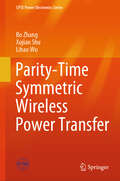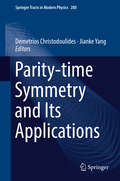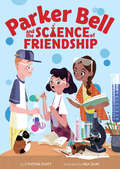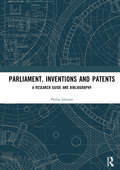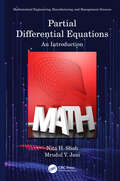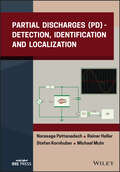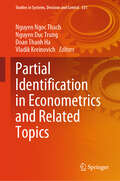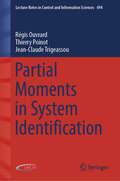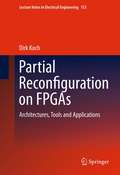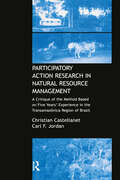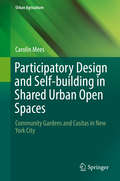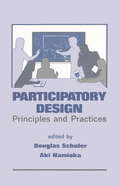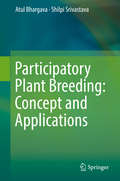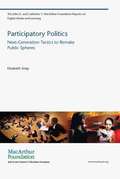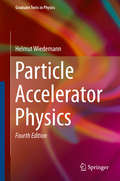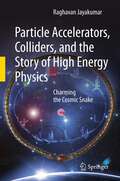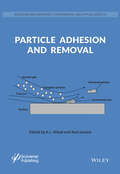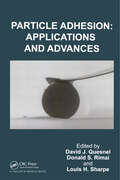- Table View
- List View
Parity-Time Symmetric Wireless Power Transfer (CPSS Power Electronics Series)
by Bo Zhang Xujian Shu Lihao WuThis book belongs to the subject of Electric Engineering, and involves the concept of PT symmetry in quantum mechanics. It presents a concise and insightful view of the knowledge on PT symmetric circuits. This book first offers an overview of the development and challenges of wireless power transfer technology, as well as the introduction of PT symmetry in wireless power transfer, and then briefly introduces PT symmetry and its representation in circuits, so as to present the realization methods of negative resistor as the key component of PT symmetric circuits. On this basis, PT symmetric wireless power transfer systems are constructed, and their characteristics, including constant power, constant efficiency, constant voltage and constant current, are analyzed. Therein, the system designs and implementations are also mentioned. Next, the various techniques for improving performances of PT symmetric wireless power transfer, such as improvement of transfer distance, reduction of switching frequency and losses, etc. Moreover, the basic structures, transfer characteristics, system designs and implementations of different types of PT symmetric wireless power transfer systems are proposed, including multi-load system, multi-relay coil system, capacitive coupled system, inductive and capacitive dual-coupled system. Therefore, this book provides readers with enough background and understanding to go deeper in the topic of PT symmetric wireless power transfer, so that this book can be used as a textbook for courses related to PT symmetric circuits, PT symmetric wireless power transfer, etc. This book is intended for students without an extensive mathematical background, and is suitable for advanced undergraduate and graduate students, engineers and researchers who focus on the PT symmetric circuits, PT symmetric wireless power transfer systems.
Parity-time Symmetry and Its Applications (Springer Tracts in Modern Physics #280)
by Demetrios Christodoulides Jianke YangThis book offers a comprehensive review of the state-of-the-art theoretical and experimental advances in linear and nonlinear parity-time-symmetric systems in various physical disciplines, and surveys the emerging applications of parity-time (PT) symmetry. PT symmetry originates from quantum mechanics, where if the Schrodinger operator satisfies the PT symmetry, then its spectrum can be all real. This concept was later introduced into optics, Bose-Einstein condensates, metamaterials, electric circuits, acoustics, mechanical systems and many other fields, where a judicious balancing of gain and loss constitutes a PT-symmetric system. Even though these systems are dissipative, they exhibit many signature properties of conservative systems, which make them mathematically and physically intriguing. Important PT-symmetry applications have also emerged. This book describes the latest advances of PT symmetry in a wide range of physical areas, with contributions from the leading experts. It is intended for researchers and graduate students to enter this research frontier, or use it as a reference book.
Parker Bell and the Science of Friendship
by Cynthia PlattIn this fun young-middle-grade novel with STEM appeal, Parker really wants to win the school Science Triathlon—but first she’ll have to figure out how to keep her BFF from being stolen.Budding scientist Parker Bell really wants to win the school Science Triathlon and follow in the footsteps of her idols, chimpanzee expert Jane Goodall and astronaut Mae Jemison. She’s sure that if she teams up with her trivia whiz BFF, Cassie, they will dominate the Science Bee, Egg Drop, and Animal Adaptation Presentation. When Cassie invites her new friend, Theo, to join their team, Parker is worried—that Theo won't help them win and might steal her best friend. As the three work together, Parker learns that you don’t have to be the best to be a real scientist and a good friend.
Parliament, Inventions and Patents: A Research Guide and Bibliography
by Phillip JohnsonThis book is a research guide and bibliography of Parliamentary material, including the Old Scottish Parliament and the Old Irish Parliament, relating to patents and inventions from the early seventeenth century to 1976. It chronicles the entire history of a purely British patent law before the coming into force of the European Patent Convention under the Patents Act 1977. It provides a comprehensive record of every Act, Bill, Parliamentary paper, report, petition and recorded debate or Parliamentary question on patent law during the period. The work will be an essential resource for scholars and researchers in intellectual property law, the history of technology, and legal and economic history.
Partial Differential Equations: An Introduction (Mathematical Engineering, Manufacturing, and Management Sciences)
by Nita H. Shah Mrudul Y. JaniDifferential equations play a noticeable role in engineering, physics, economics, and other disciplines. They permit us to model changing forms in both mathematical and physical problems. These equations are precisely used when a deterministic relation containing some continuously varying quantities and their rates of change in space and/or time is recognized or postulated. This book is intended to provide a straightforward introduction to the concept of partial differential equations. It provides a diversity of numerical examples framed to nurture the intellectual level of scholars. It includes enough examples to provide students with a clear concept and also offers short questions for comprehension. Construction of real-life problems is considered in the last chapter along with applications. Research scholars and students working in the fields of engineering, physics, and different branches of mathematics need to learn the concepts of partial differential equations to solve their problems. This book will serve their needs instead of having to use more complex books that contain more concepts than needed.
Partial Discharges in Hydroelectric Generators: Detection, Processing, Classification, and Pinpointing (Power Systems)
by Victor Dmitriev Rodrigo M. Oliveira Ronaldo F. Zampolo Paulo R. Moutinho de Vilhena Fernando de Souza Brasil Martim Felipe FernandesEffective implementation of predictive maintenance programs in power plants requires the online condition monitoring of electrical generators. This book offers a comprehensive guide on the measurement, detection, and interpretation of partial discharges in hydroelectric generators. It covers a range of essential topics such as the physics of partial discharge phenomenon, various types of defects and partial discharge patterns, sensors and acquisition procedures, signal processing techniques, automatic classification of discharge types, and correlation between partial discharge occurrence and ozone generation. Numerical modelling of partial discharges and calculation of the associated radiating electromagnetic fields are also discussed. To aid understanding, the book provides theoretical explanations, practical examples, and functional Python code on Google’s Colaboratory platform. This book is a valuable resource for anyone seeking a deep understanding of partial discharges in hydroelectric generators.Presents in-depth theory with examples;Provides experimental data illustrating effects of PD in machine components;Includes functional Python and C code examples.
Partial Discharges: Detection, Identification and Localization (IEEE Press)
by Norasage Pattanadech Michael Muhr Rainer Haller Stefan KornhuberPARTIAL DISCHARGES (PD) — DETECTION, IDENTIFICATION AND LOCALIZATION Explore state-of-the-art partial discharge measurement techniques In Partial Discharges (PD) — Detection, Identification and Localization, a team of distinguished electrical engineers delivers a comprehensive treatment of the behavior, modeling, measurement, monitoring, localization, and evaluation of partial discharges. It includes coverage of all major advancements in the field that have occurred over the last few decades. It also discusses partial discharge phenomena, detection methods, and strategies for analyzing and processing collected data. Mechanisms of insulation failure are explored, as is the denoising of partial discharge measurement data and the localization of partial discharge in large, high-voltage equipment. Non-electric principles and procedures are discussed, and the book offers a variety of tables, figures, and photographs to illustrate the concepts discussed within. Partial Discharges(PD) also provides: A thorough introduction to the physical behavior of partial discharges, including their causes and classification Comprehensive modeling of partial discharge behavior, including classical and dipole discharges Practical discussions of the measurement of partial discharges, including the electrical method, partial discharge decoupling, and pre- and post-processing of partial discharges In-depth examinations of the monitoring of partial discharge behavior, including methods and realization Perfect for electrical engineers engaged in electrical power engineering, Partial Discharges (PD) will also earn a place in the libraries of research and development specialists employed in the manufacturing, quality testing and operation of electrical systems.
Partial Identification in Econometrics and Related Topics (Studies in Systems, Decision and Control #531)
by Vladik Kreinovich Nguyen Ngoc Thach Nguyen Duc Trung Doan Thanh HaThis book covers data processing techniques, with economic and financial application being the unifying theme. To make proper investments in economy, the authors need to have a good understanding of the future trends: how will demand change, how will prices change, etc. In general, in science, the usual way to make predictions is: to identify a model that best fits the current dynamics, and to use this model to predict the future behavior. In many practical situations—especially in economics—our past experiences are limited. As a result, the authors can only achieve a partial identification. It is therefore important to be able to make predictions based on such partially identified models—which is the main focus of this book. This book emphasizes partial identification techniques, but it also describes and uses other econometric techniques, ranging from more traditional statistical techniques to more innovative ones such as game-theoretic approach, interval techniques, and machine learning. Applications range from general analysis of GDP growth, stock market, and consumer prices to analysis of specific sectors of economics (credit and banking, energy, health, labor, tourism, international trade) to specific issues affecting economy such as ecology, national culture, government regulations, and the existence of shadow economy. This book shows what has been achieved, but even more important are remaining open problems. The authors hope that this book will: inspire practitioners to learn how to apply state-of-the-art techniques, especially techniques of optimal transport statistics, to economic and financial problems, andinspire researchers to further improve the existing techniques and to come up with new techniques for studying economic and financial phenomena. The authors want to thank all the authors for their contributions and all anonymous referees for their thorough analysis and helpful comments. The publication of this book—and organization of the conference at which these papers were presented—was supported: by the Ho Chi Minh University of Banking (HUB), Vietnam, and by the Vingroup Innovation Foundation (VINIF). The authors thank the leadership and staff of HUB and VINIF for providing crucial support.
Partial Least Squares Structural Equation Modeling and Complementary Methods in Business Research (Information Systems Engineering and Management #67)
by Gül Erkol Bayram Alhamzah Alnoor Yousif Raad Muhsen XinYing Chew Abbas Gatea Atiyah Sammar AbbasThis book offers a practical and accessible guide to Partial Least Squares Structural Equation Modeling (PLS-SEM) in business research, while addressing its limitations by integrating complementary methods such as artificial neural networks (ANN), fuzzy-set qualitative comparative analysis (fsQCA), and multi-criteria decision-making (MCDM). It supports early-career researchers, postgraduate students, and practitioners in navigating complex models, predictive analytics, and latent construct measurement. By focusing on emerging business issues like digital transformation, metaverse, and sustainability, this book delivers clear, applied insights. Readers gain not only foundational knowledge of PLS-SEM but also strategies for enhancing research rigor, prediction, and decision-making using hybrid approaches. This is a timely and essential resource for scholars aiming to advance their methodological toolkit for impactful and actionable business research.
Partial Moments in System Identification (Lecture Notes in Control and Information Sciences #494)
by Jean-Claude Trigeassou Régis Ouvrard Thierry PoinotThis book provides a complete round-up of developments concerned with the application of partial moments in system identification and data-driven modelling; it captures the essence of work carried out at the Laboratoire d'Informatique et d'Automatique pour les Systèmes for more than 40 years. The book begins with introductory material, describing both the mathematical tools associated with partial moments and reinitialized partial moments and an example demonstrating their use. The authors then proceed to show how these tools can be used for the identification of continuous-time linear models, discrete-time linear models, continuous-time linear state-space models, linear parameter-varying models and multidimensional models based on partial differential equations. The properties and performances of each of these approaches are presented. The analogy with algebraic approaches is proved, thus opening perspectives for extension to other fields. The text removes some long-standing limitations on the implementation of partial-moment-based tools in system identification. This book is of interest to researchers and postgraduates studying system identification, control theory, applied mathematics and computer science. It is also useful for engineers working on industrial applications of the parametric estimation of mathematical models.
Partial Reconfiguration on FPGAs
by Dirk KochThis is the first book to focus on designing run-time reconfigurable systems on FPGAs, in order to gain resource and power efficiency, as well as to improve speed. Case studies in partial reconfiguration guide readers through the FPGA jungle, straight toward a working system. The discussion of partial reconfiguration is comprehensive and practical, with models introduced together with methods to implement efficiently the corresponding systems. Coverage includes concepts for partial module integration and corresponding communication architectures, floorplanning of the on-FPGA resources, physical implementation aspects starting from constraining primitive placement and routing all the way down to the bitstream required to configure the FPGA, and verification of reconfigurable systems.
Partially Coherent Optical Transmission Theory in Optical Wireless Communication (Optical Wireless Communication Theory and Technology)
by Xizheng KeThis book introduces the theory and research methods of partially coherent optical, points out the significance of this study, analyzes the basic theories involved in partially coherent light, and explains the complete coherence of laser is not a necessary condition for good directivity, and partially spatially coherent optical sources can also produce the same far-field intensity distribution as lasers. This type of beam with good directivity but only partial spatial coherence is called a Gaussian Schell model beam, which can be used as a physical model to describe multimode lasers under certain conditions. This book is applicable to the large number of engineers and technicians involved in wireless optical communication and college teachers. It can also be used as a teaching material for graduate students and senior undergraduates in related fields.
Participant Handbook - Data Entry Operator (Divyangjan)
by Skill Council for Persons with DisabilityThe Participant Handbook - Data Entry Operator (Divyangjan) is a comprehensive guide designed to provide skill-based training for individuals with disabilities, focusing on the role of Domestic Data Entry Operators within the IT-ITeS sector. It aligns with the National Occupational Standards and offers structured learning through a modular approach. Covering essential aspects like data entry processes, software requirements, troubleshooting, and employability skills, the handbook emphasizes accuracy, professionalism, and error mitigation in data handling. It also incorporates guidelines for leveraging automation technologies such as OCR and AI to enhance efficiency, while addressing the unique needs of participants through tailored content for various disabilities.
Participatory Action Research in Natural Resource Management: A Critque of the Method Based on Five Years' Experience in the Transamozonica Region of Brazil
by Carl F. Jordan Christian CastellanetThis work evaluates the merits of a widely-used approach to natural resource management, participatory action research (PAR), an approach to resource management that strives to link researchers with farmers and other local residents whose lives are effected by long-range conservation programmes. The authors begin the book with the history of PAR, and then use a variety of case studies that chronicle sustainable development efforts in Brazil. They evaluate the strengths and weaknesses of these efforts and suggest specific ways to improve on future PAR efforts.
Participatory Design and Self-building in Shared Urban Open Spaces: Community Gardens And Casitas In New York City (Urban Agriculture Ser.)
by Carolin MeesThe book investigates the development of community gardens with self-built structures, which have existed as a shared public open space land use form in New York City’s low-come neighborhoods like the South Bronx since the 1970s. These gardens have continued to be part of the urban landscape until today, despite conflicting land use interests, changing residents groups and contradictory city planning. Both community gardens and self-built structures are created in a participatory design and self-built effort by urban residents and are an expression of the individual gardeners’ preferences, their cultural background and the decisions made by the managing residents’ group in regards to the needs of their neighborhood. Ultimately community gardens with self-built structures are an expression of the people’s will to commonly use this land for open and enclosed structures next to their homes in the city and need to be included in future urban planning.
Participatory Design: Principles and Practices
by DOUGLAS SCHULER AND AKI NAMIOKAThe voices in this collection are primarily those of researchers and developers concerned with bringing knowledge of technological possibilities to bear on informed and effective system design. Their efforts are distinguished from many previous writings on system development by their central and abiding reliance on direct and continuous interaction with those who are the ultimate arbiters of system adequacy; namely, those who will use the technology in their everyday lives and work. A key issue throughout is the question of who does what to whom: whose interests are at stake, who initiates action and for what reason, who defines the problem and who decides that there is one. The papers presented follow in the footsteps of a small but growing international community of scholars and practitioners of participatory systems design. Many of the original European perspectives are represented here as well as some new and distinctively American approaches. The collection is characterized by a rich and diverse set of perspectives and experiences that, despite their differences, share a distinctive spirit and direction -- a more humane, creative, and effective relationship between those involved in technology's design and use, and between technology and the human activities that motivate the technology.
Participatory Plant Breeding: Concept and Applications
by Shilpi Srivastava Atul BhargavaPlant breeding has played a significant role in the development of human civilizations. Conventional plant breeding has significantly improved crop yield by genetically manipulating agronomically important traits. However, it has often been criticized for ignoring indigenous germplasm, failing to address the needs of the marginal and the poor farmers, and emphasizing selection for broad instead of local adaptation. Participatory plant breeding (PPB) is the process by which the producers and other stakeholders are actively involved in a plant-breeding programme, with opportunities to make decisions throughout. The Working Group on Participatory Plant Breeding (PPBwg) was established in 1996 under the framework of the Consultative Group on International Agricultural Research (CGIAR). Research in PPB can promote informed participation and trust in research among consumers and producers, and in recent years, PPB has had a significant impact on food production by quickly and cost-effectively producing improved crop varieties. At the same time, there has been significant research in the area. PPB offers significant advantages that are particularly relevant to developing countries where large investments in plant breeding have not led to increased production, especially in the marginal environments. In addition to the economic benefits, participatory research has a number of psychological, moral, and ethical benefits, which are the consequence of a progressive empowerment of the farming communities. PPB can empower groups such as women or less well-off farmers that are traditionally left out of the development process.This book explores the potential of PPB in the coming decades. The topic is more relevant since international breeding efforts for major crops are aimed at decentralizing local breeding methods to better incorporate the perspective of end users into the varietal development process. The first book incorporating the upcoming research on this novel breeding approach, it reviews the important tools and applications of PPB in an easy-to-read, succinct format, with illustrations to clarify these complex topics. It provides readers with a basic idea of participatory plant breeding as well as advances in the field and insights into the future to facilitate the successful integration of farmers into breeding programmes.This book is a valuable reference resource for agriculturists, agricultural advisers, policy makers, NGOs, post-doctoral students and scientists in agriculture, horticulture, forestry and botany.
Participatory Politics
by Elisabeth SoepAlthough they may disavow politics as such, civic-minded young people use every means and media at their disposal to carry out the basic tasks of citizenship. Through a mix of face-to-face and digital methods, they deliberate on important issues and debate with peers and powerbrokers, redefining some key dynamics that govern civic life in the process. In Participatory Politics, Elisabeth Soep examines the specific tactics used by young people as they experiment with civic engagement. Drawing on her scholarly research and on her work as a media producer and educator, Soep identifies five tactics that are part of effective, equitable participatory politics among young people: Pivot Your Public (mobilizing civic capacity within popular culture engagements); Create Content Worlds (using inventive and interactive storytelling that sparks sharing); Forage for Information in public data archives; Code Up (using computational thinking to design tools, platforms, and spaces for public good); and Hide and Seek (protecting privacy and information sources). After describing these tactics as they manifest themselves in a range of youth-driven activities -- from the runaway spread of the video Kony 2012 to community hackathons -- Soep discusses concrete ideas for cultivating the new literacies that will enable young people to participate in public life. She goes on to consider some risks associated with these participatory tactics, including simplification and sensationalism, and ways to avoid them, and concludes with implications for future research and practice.
Particle Accelerator Physics: Basic Principles And Linear Beam Dynamics (Graduate Texts in Physics)
by Helmut WiedemannThis book by Helmut Wiedemann is a well-established, classic text, providing an in-depth and comprehensive introduction to the field of high-energy particle acceleration and beam dynamics.The present 4th edition has been significantly revised, updated and expanded. The newly conceived Part I is an elementary introduction to the subject matter for undergraduate students. Part II gathers the basic tools in preparation of a more advanced treatment, summarizing the essentials of electrostatics and electrodynamics as well as of particle dynamics in electromagnetic fields. Part III is an extensive primer in beam dynamics, followed, in Part IV, by an introduction and description of the main beam parameters and including a new chapter on beam emittance and lattice design. Part V is devoted to the treatment of perturbations in beam dynamics. Part VI then discusses the details of charged particle acceleration. Parts VII and VIII introduce the more advanced topics of coupled beam dynamics and describe very intense beams – a number of additional beam instabilities are introduced and reviewed in this new edition. Part IX is an exhaustive treatment of radiation from accelerated charges and introduces important sources of coherent radiation such as synchrotrons and free-electron lasers. The appendices at the end of the book gather useful mathematical and physical formulae, parameters and units. Solutions to many end-of-chapter problems are given.This textbook is suitable for an intensive two-semester course starting at the senior undergraduate level.
Particle Accelerators, Colliders, and the Story of High Energy Physics
by Raghavan JayakumarThe Nordic mythological Cosmic Serpent, Ouroboros, is said to be coiled in the depths of the sea, surrounding the Earth with its tail in its mouth. In physics, this snake is a metaphor for the Universe, where the head, symbolizing the largest entity - the Cosmos - is one with the tail, symbolizing the smallest - the fundamental particle. Particle accelerators, colliders and detectors are built by physicists and engineers to uncover the nature of the Universe while discovering its building blocks. "Charming the Cosmic Snake" takes the readers through the science behind these experimental machines: the physics principles that each stage of the development of particle accelerators helped to reveal, and the particles they helped to discover. The book culminates with a description of the Large Hadron Collider, one of the world's largest and most complex machines operating in a 27-km circumference tunnel near Geneva. That collider may prove or disprove many of our basic theories about the nature of matter. The book provides the material honestly without misrepresenting the science for the sake of excitement or glossing over difficult notions. The principles behind each type of accelerator is made accessible to the undergraduate student and even to a lay reader with cartoons, illustrations and metaphors. Simultaneously, the book also caters to different levels of reader's background and provides additional materials for the more interested or diligent reader.
Particle Adhesion and Removal
by K. L. Mittal Ravi JaiswalThe book provides a comprehensive and easily accessible reference source covering all important aspects of particle adhesion and removal. <P><P> The core objective is to cover both fundamental and applied aspects of particle adhesion and removal with emphasis on recent developments. Among the topics to be covered include: 1. Fundamentals of surface forces in particle adhesion and removal. 2. Mechanisms of particle adhesion and removal. 3. Experimental methods (e.g. AFM, SFA,SFM,IFM, etc.) to understand particle-particle and particle-substrate interactions. 4. Mechanics of adhesion of micro- and nanoscale particles. 5. Various factors affecting particle adhesion to a variety of substrates. 6. Surface modification techniques to modulate particle adhesion. 7. Various cleaning methods (both wet & dry) for particle removal. 8. Relevance of particle adhesion in a host of technologies ranging from simple to ultra-sophisticated.
Particle Adhesion: Applications and Advances
by Donald S. Rimai Louis H. Sharpe David J. QuesnelWhenever a curved surface interacts with another surface, the principles of adhesion are at work. From the cells in your body to the dust on your glasses, intermolecular forces cause materials to attract one another. Elastic deformations resulting from these adhesive interactions store strain that can be liberated during particle detachment. Time d
Particle Confinement in Penning Traps: An Introduction (Springer Series on Atomic, Optical, and Plasma Physics #126)
by Manuel VogelThis second edition is an updated and extended introduction to the world of Penning traps and provides an overview of the field, particularly for those entering it. The book presents the basics of Penning traps from a fundamental and applied point of view and discusses the variety of methods, technologies and their applications to experiments, particularly in the field of precision spectroscopy across all frequency ranges. The book is written from an experimentalist's point of view, it includes numerous new illustrations and updated references to the available literature to ensure a high degree of breadth and accessibility.The new edition provides, for instance, a new chapter on particle temperature and cooling, new sections on particle dynamics, g-factor measurements, space charge as a confinement limitation, space charge and resonant particle loss, as well as a section on particle loss mechanisms.
Particle Control for Semiconductor Manufacturing
by DonovanThere is something Alice-in-Wonderlandish about powerful and vital computer systems being shut down by a microscopic mote that a hay-feverist wouldn't sneeze at, but as computer chips get smaller, smaller and smaller particles on their surface have a larger and larger effect on their performance. In
Particle Damping Technology Based Structural Control (Springer Tracts In Civil Engineering)
by Zheng Lu Sami F. Masri Xilin LuThis book presents a systematic introduction to particle damping technologies, which can be used to effectively mitigate seismic-induced and wind-induced vibration in various structures. Further, it offers comprehensive information on the latest research advances, e.g. a refined simulation model based on the discrete element method and a simplified simulation model based on equivalent principles. It then intensively studies the vibration attenuation effects of particle dampers subjected to different dynamic loads; in this context, the book proposes a new damping mechanism and “global’’ measures that can be used to evaluate damping performance. Moreover, the book uses the shaking table test and wind tunnel test to verify the proposed simulation methods, and their satisfactory damping performance is confirmed. To facilitate the practical engineering application of this technology, optimization design guidelines for particle impact dampers are also provided. In closing, the book offers a preliminary exploration of semi-active particle damping technology, which holds great potential for extension to other applications in which the primary system is subjected to non-stationary excitations.
